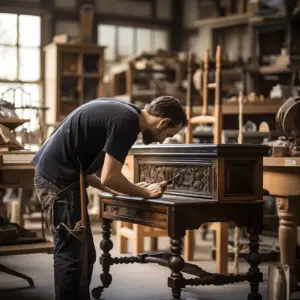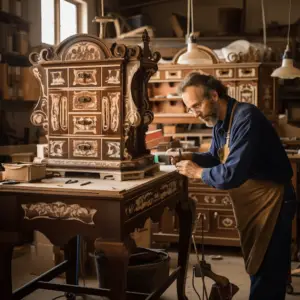Table of Contents
The Art of Restoring Furniture

Text:
Furniture restoration – an intriguing craft! Reviving old furniture pieces, transforming them into beautiful artworks. It needs skillful artisans who comprehend the materials used and techniques required to bring back the furniture’s former glory.
This craft includes several materials, like wood, metal, upholstery, and leather. Each material needs particular techniques to show its beauty and maintain its integrity. For instance, refinishing wood involves sanding away old finishes and adding new ones, giving a shiny surface that shows the natural grain patterns. Reupholstering upholstery breathes life into worn-out fabrics, giving them a fresh look.
Moreover, polishing metal items like handles or hinges can restore their original sparkle. Conditioning leather furniture makes sure it keeps its supple texture over time. These are just some of the meticulous work involved in furniture restoration.
Do you know that furniture restoration dates back centuries? In ancient Egypt, craftsmen were highly admired for their ability to restore and enhance furniture pieces for pharaohs and nobles. This tradition has been ongoing, with artisans honing their skills and passing down their knowledge from generation to generation.
Furniture restoration: hiding wine stains and years of neglect was never easier!
Importance of Furniture Restoration
To understand the importance of furniture restoration, dive into the world of preserving antiques. Discover the significance it holds and the benefits it brings. Explore the art of giving new life to old furniture, showcasing its historical value, and revitalizing its aesthetics.
The Significance of Preserving Antiques
Preserving antiques is crucial. It allows us to appreciate our cultural heritage and history. These artifacts are like windows into the past, carrying stories of days gone by. Refurbishing them not only maintains their appearance, but also secures their historical meaning.
We give antiques a new life, so they can survive for years to come. By carefully restoring each intricate detail, their authenticity and craftsmanship are kept intact. Thus, future generations can gain insight into the ingenuity of our ancestors.
Moreover, restoring antiques is beneficial for the environment. Instead of throwing away furniture that has deteriorated, restoration provides a responsible option. This encourages conscious consumption and reverence for furniture designed to last.
In addition, antique preservation can add charm to any space. Incorporating these timeless pieces into our homes or offices combines old-world glamour and modern aesthetics. It brings back nostalgia while displaying admiration for artistry from times past.
It is essential to take advantage of preserving antiques. Let us not let these invaluable treasures vanish. Taking part in furniture restoration keeps our relationship with history alive and passes on its beauty to later generations.
So, embrace the beauty of preserving antiques and embark on a journey that mixes artistry and history. Let your surroundings tell captivating stories by these restored gems while helping to create a sustainable future – one antique at a time! Bring old furniture back to life – it’s the ultimate makeover show without the drama.
Different Techniques and Methods in Furniture Restoration
To restore furniture effectively and efficiently, discover different techniques and methods. Repairing damaged furniture is one such technique. It focuses on repairing and fixing any damages or flaws in the furniture to enhance its overall condition.
Repairing Damaged Furniture
- Step 1: Assess the Damage.
Take a good look at the piece of furniture. Check for cracks, chips, dents and scratches. This will help you plan the restoration process. - Step 2: Gather Materials and Tools.
Grab everything you need, like wood filler, sandpaper, glue, clamps, paint or stain, brushes and protective finishes. - Step 3: Repair Cracks and Structural Damage.
Fill in the damaged areas with wood filler. Follow the instructions for drying time. Sand down any excess filler until it blends in. - Step 4: Fix Chips and Dents.
Use a putty knife to apply filler on chips and dents. When it’s dry, sand it down until smooth. If there are larger chips, patch or replace sections of wood. - Step 5: Enhance Aesthetics.
Sand down the surface to remove old finishes or paint. Apply a new coat of paint or stain that matches the original. Finally, protect it with varnish or wax. - Step 6: Reassemble if Necessary.
If you had to take the furniture apart, put it back together with adhesives or fasteners. Make sure each part fits snugly.
For more tips, attend workshops or ask other experienced professionals. Practice and patience are key to successful furniture restoration.
People are now appreciating the value of craftsmanship and giving new life to old pieces. There are restoration communities and businesses for enthusiasts and experts to exchange knowledge. So, don’t throw away battered furniture, restore it to its former glory!
Choosing the Right Materials and Tools for Restoration

Choosing the right materials and tools for restoration is vital for success. The selection of resources can majorly affect the quality and durability of the restored furniture. Consider factors such as the type of wood, fabric, or metal used in the original piece, as well as any particular needs or preferences you may have.
To help you decide, here is a table with useful info on common materials and tools used in furniture restoration:
| Material/Tool | Description |
|---|---|
| Wood glue | A strong adhesive to bond wooden components. |
| Sandpaper | Abrasive paper to smooth surfaces and remove stains. |
| Stain | Pigmented liquid applied to wood for colorisation. |
| Varnish | Protective coating to enhance the look of wood. |
| Upholstery fabric | Durable textile for covering chairs and sofas. |
| Staple gun | A handheld device to secure fabric or leather onto frames. |
In addition to these materials and tools, think about other factors when choosing resources for furniture restoration. For instance, different types of varnish will give different finishes, from glossy to matte. Similarly, various grades of sandpaper can be chosen based on the roughness wanted.
Take into account any unique features of your piece that may require special materials or tools. For example, if restoring an antique chair with intricate carvings or delicate details, specialized carving tools and fine brushes might be necessary.
Pro Tip: Research and ask experienced people for guidance tailored to your needs and goals before starting your restoration project.
By selecting proper materials and tools for furniture restoration, you can ensure a successful outcome that revitalizes your pieces while preserving their historical significance and artistic value.